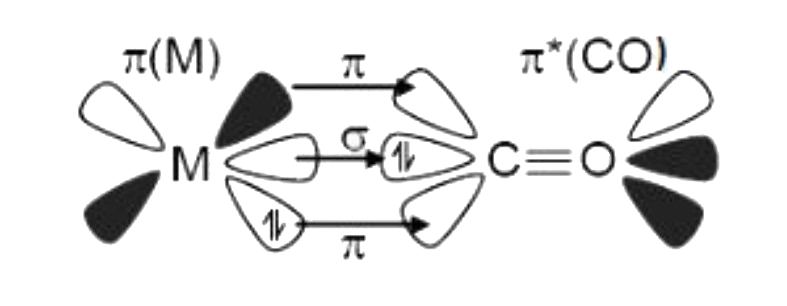Metal 'M' forms a carbonly compound in which it is present in its lower valance state. Which of the following bonding is possible in this metal carbonly?




The correct Answer is:B
To solve the question regarding the bonding in the carbonyl compound formed by metal 'M' in its lower valence state, we will follow these steps:
Step 1: Understand the Structure of Carbon Monoxide (CO)
Carbon monoxide (CO) is a diatomic molecule consisting of one carbon atom and one oxygen atom. The bonding in CO involves both sigma (σ) and pi (π) bonds. CO has a total of 14 electrons, which fill the molecular orbitals in a specific order.
Hint: Recall the electron configuration and molecular orbital theory to understand how electrons are distributed in CO.
Step 2: Fill the Molecular Orbitals
The molecular orbital energy levels for CO are as follows:
- σ1s
- σ*2s
- σ2s
- π2px
- π2py
- σ2pz
- π*2px
- π*2py
Filling the 14 electrons into these orbitals:
1. σ1s: 2 electrons
2. σ*2s: 2 electrons
3. σ2s: 2 electrons
4. π2px: 2 electrons
5. π2py: 2 electrons
6. σ2pz: 2 electrons
7. π*2px: 1 electron
8. π*2py: 1 electron
Hint: Remember that each molecular orbital can hold a maximum of 2 electrons, and the filling follows the Aufbau principle.
Step 3: Identify the Bonding Types
In the carbonyl compound, the carbon atom donates a lone pair of electrons to the metal atom. The metal can accept these electrons into its vacant orbitals. The bonding that occurs here involves:
- A sigma bond formed by the overlap of the metal's orbital with the carbon's orbital.
- A pi bond formed by the donation of the lone pair from carbon to the metal's vacant pi* orbital.
Hint: Think about how metals can form bonds by accepting electron pairs and how this relates to their vacant orbitals.
Step 4: Determine the Type of Bonding
The bonding in the carbonyl compound can be classified as:
- Sigma (σ) bonding: from the overlap of orbitals.
- Pi (π) bonding: from the donation of the lone pair from carbon to the metal's vacant pi* orbital.
Thus, the bonding possible in the metal carbonyl involves both sigma and pi bonding.
Hint: Consider the nature of the bonds and how they contribute to the stability of the carbonyl compound.
Final Answer:
The bonding possible in the metal carbonyl compound formed by metal 'M' in its lower valence state includes both sigma (σ) and pi (π) bonding.
Carbon monoxide (CO) is a diatomic molecule consisting of one carbon atom and one oxygen atom. The bonding in CO involves both sigma (σ) and pi (π) bonds. CO has a total of 14 electrons, which fill the molecular orbitals in a specific order.
The molecular orbital energy levels for CO are as follows:
- σ1s
- σ*2s
- σ2s
- π2px
- π2py
- σ2pz
- π*2px
- π*2py
1. σ1s: 2 electrons
2. σ*2s: 2 electrons
3. σ2s: 2 electrons
4. π2px: 2 electrons
5. π2py: 2 electrons
6. σ2pz: 2 electrons
7. π*2px: 1 electron
8. π*2py: 1 electron
In the carbonyl compound, the carbon atom donates a lone pair of electrons to the metal atom. The metal can accept these electrons into its vacant orbitals. The bonding that occurs here involves:
- A sigma bond formed by the overlap of the metal's orbital with the carbon's orbital.
- A pi bond formed by the donation of the lone pair from carbon to the metal's vacant pi* orbital.
The bonding in the carbonyl compound can be classified as:
- Sigma (σ) bonding: from the overlap of orbitals.
- Pi (π) bonding: from the donation of the lone pair from carbon to the metal's vacant pi* orbital.
The bonding possible in the metal carbonyl compound formed by metal 'M' in its lower valence state includes both sigma (σ) and pi (π) bonding.
Topper's Solved these Questions
Similar Questions
Knowledge Check
Metal 'M' forms as carbonyl compound in which it is present in its lower valence state. Which of the following bonding is possible is this metal carbonyl ?
A B
B C
C D
D
In which of the following compounds , back bonding is possible
APF3BPH3CNH3DNF3The complex compound in which metal is not present in zero oxidation state?
AMn2(CO)10B[Ni(CO)4]C[cr(C6H6)2]DK[PtCI3(C2H4)]
Which of the following does not have a metal carbon bond?
View SolutionWhich of the following does not have a metal carbon bond?
View SolutionWhich of the following does not have a metal-carbon bond?
View SolutionIn which of the following metal to metal bond is present ?
View SolutionWhich of the following has metal-metal bond ?
View Solution